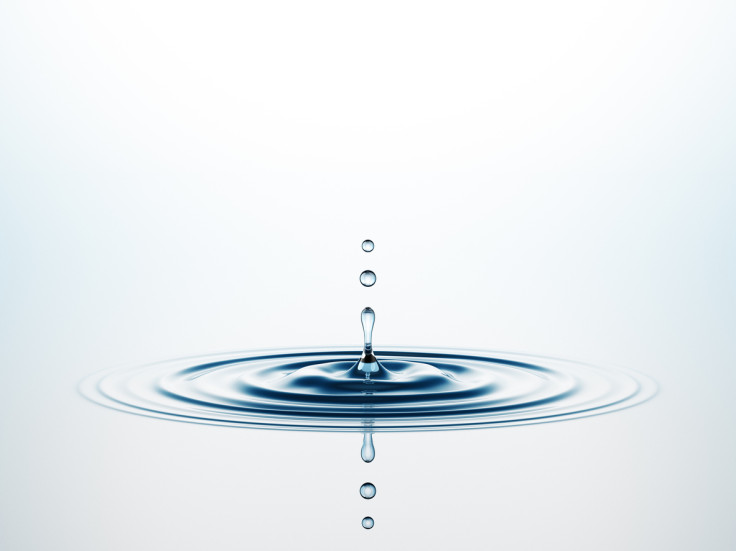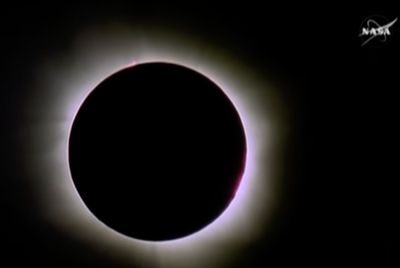Why does water splash? We may just have solved this longstanding physics mystery
Understanding this has wide-ranging applications - from blood splatter analysis to climate change.

James Sprittles, University of Warwick
From the raindrops that soak you on your way to work to the drops of coffee that inevitably end up on your white shirt when you arrive, you'd be forgiven for thinking of drops as a mere nuisance.
But beneath a mundane facade, droplets exhibit natural beauty and conceal complex physics that scientists have been trying to figure out for decades. Recently, I have contributed to this field by working on a new theory explaining what happens to the critical thin layer of air between a drop of water and a surface to cause a splash.
At just a few thousandths of a second, the lifetime of a splashing drop is too rapid for us to see. It took pioneering advances in high-speed imaging to capture these events – the most iconic being Edgerton's Milk Drop Coronet in 1957. These pictures simultaneously captured the public's imagination with their aesthetic nature while intriguing physicists with their surprising complexity. The most obvious question is why, and when, do drops splash?
Nowadays, cameras can take over a million frames per second and resolve the fine details of a splash. However, these advances have raised as many questions as they have answered. Most importantly, remarkable observations, coming from the NagelLab in 2005, showed that the air surrounding the drop plays a critical role. By reducing the air pressure, one can prevent a splash (see second video). In fact, drops which splash at the bottom of Mount Everest may not do so at the top, where the air pressure is lower.
The discoveries created an explosion of experimental work aimed at uncovering the curious details of the air's role. New experimental methods revealed incredible dynamics: millimetre-sized liquid drops are controlled by the behaviour of microscopic air films that are 1,000 times smaller.
Notably, after a liquid drop contacts a solid it can be prevented from spreading across it by a microscopically thin layer of air that it can't push aside. The sizes involved are equivalent to a one-centimetre layer of air stopping a tsunami wave spreading across a beach. When this occurs, a sheet of liquid can fly away from the main drop and break into smaller droplets – so that a splash is generated.
Major breakthrough
Experimental analyses have produced incredibly detailed observations of drops splashing. But they do not establish why the drops splash, which means we don't understand the underlying physics. Remarkably, for such a seemingly innocuous problem the classical theory of fluids – used to forecast weather, design ships and predict blood flow – is inadequate. This is because the air layer's height becomes comparable to the distance air molecules travel between collisions. So for this specific problem we need to feed in microscopic details that the classical theory simply doesn't account for.

The air's behaviour can only be captured by a theory originally developed for violent aerodynamic gas flows – such as for space shuttles entering the Earth's atmosphere – namely the kinetic theory of gases. My new article, published in Physical Review Letters, is the first to use kinetic theory to understand how the air film behaves as it is displaced by a liquid spreading over a solid.
The article establishes criteria for the maximum speed at which a liquid can stably spread over a solid. It was already known that for a splash to be produced, this critical speed must be exceeded. If the speed is lower than that, the drop spreads smoothly instead. Notably, the new theory explains why reducing the air pressure can suppress splashing: in this case, air escapes more easily from the layer and provides less resistance to the liquid drop. This is the missing piece of a jigsaw to which numerous important scientific contributions have been made since the experimental discoveries of 2005.
Important applications
While being of fundamental scientific interest, an understanding of the conditions that cause splashing can be exploited – leading to potential breakthroughs in a number of practical fields.
One example is 3D printing where liquid drops form the building blocks of tailor-made products such as hearing aids. Here, stopping splashing is key to making products of the desired quality. Another important area is forensic science, where blood-stain-pattern analysis relies on splash characteristics to provide insight into where the blood came from – yielding vital information in a criminal investigation.
Most promisingly, the new theory will have applications to a wide range of related flows where microscopic layers of air appear. For example, in climate science it will enable us to understand how water drops collide during the formation of clouds and to estimate the quantity of gas being dragged into our oceans by rainfall.
Do keep this in mind the next time you splatter coffee drops across your desk. Take a moment to admire the pattern and appreciate the underlying complexity before cursing and heading for your "mopper upper" of choice.
James Sprittles, Assistant Professor in Mathematics, University of Warwick
This article was originally published on The Conversation. Read the original article.
© Copyright IBTimes 2025. All rights reserved.





















